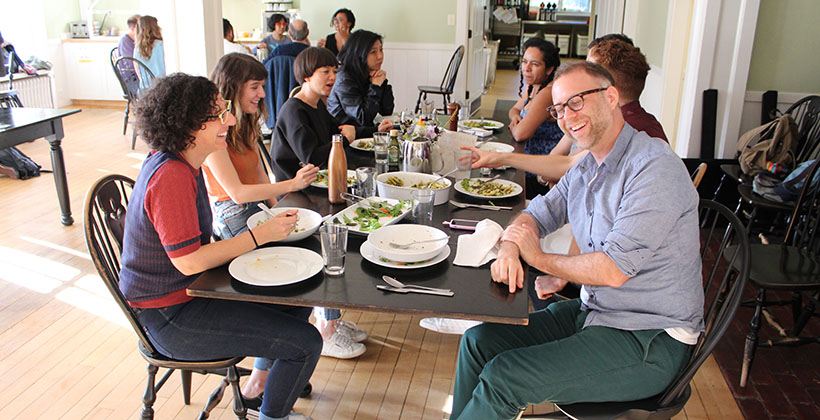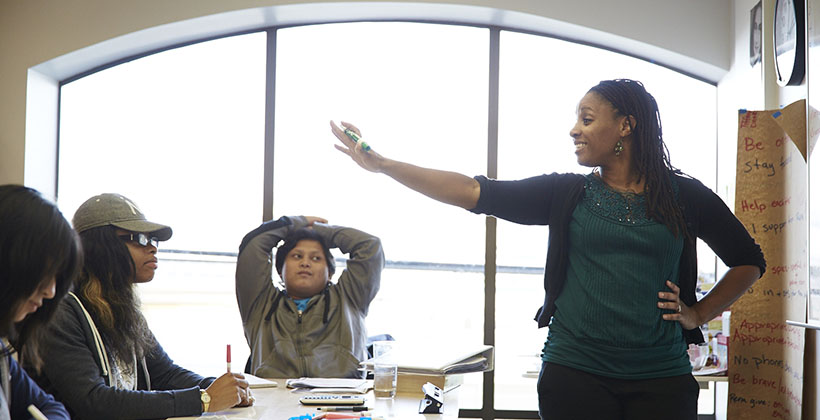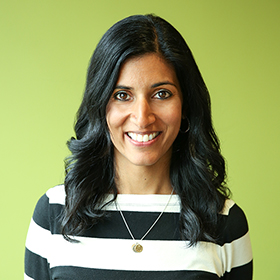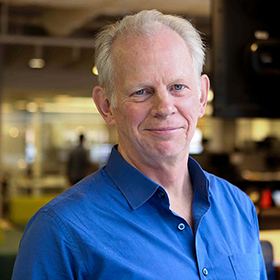One day during the summer of 2020, a team of staffers at MacDowell, the nation’s first artist residency program, met via Zoom with an ambitious agenda: begin to build a strategic playbook that would identify tangible steps to help the nonprofit amp up its resilience, even as it was battling a globe-spanning, existential threat to its future.
This article is the first of a three-part series highlighting strategies for strengthening nonprofits so that they are better prepared to push through the current crisis—and the challenges to come. Learn more about the series in the introduction, "How to Build Nonprofit Resilience."
Since its founding in 1907, MacDowell has provided a space for artists working in multiple disciplines—Leonard Bernstein and James Baldwin; Zoe Leonard, Alice Walker, and Ta‑Nehisi Coates—as they created works that nourish and challenge the world. But when the COVID-19 pandemic commenced its virulent spread, MacDowell, like so many other nonprofits, was forced to shutter its studios and suspend its in-person programs. At the very moment when people needed the sustenance of art more than ever, MacDowell’s future seemed never more clouded.
Against that dispiriting backdrop, the MacDowell team began to wrestle with a strategy for building organizational resilience: to “think long.” The animating idea was to set their sights on a far-off, lofty vision for where MacDowell might aim to land by the end of the decade. A vision that would fuel an enlarged sense of purpose and inspire contributions from everyone.
Trouble was, the pandemic had leached a sense of possibility out of more than a few team members. So, too, had the horrific events of March and May, when the police fatally shot Breonna Taylor and choked George Floyd to death. For some, the future seemed frightening or at the very least, deeply demoralizing. Commented one team member, “Ten years from now, I can’t imagine how anything could be good.”
"MacDowell has one foot in the early 21st century, and it’s trying to find its footing in the future."
MacDowell had already begun to examine its role in participating in systems of inequity, which led its executive director, Philip Himberg, to think that staffers would most likely share a common vision for its next 10 years. But that was not the case. “I thought we would all be on the same page,” Himberg recalled. “It was a real surprise that that [effort] created some dissension among our MacDowell staff and board, or at least it raised a lot of emotions.”
And yet, the conversation around equity and MacDowell’s 10-year vision created space for the organization to reflect on the “suffering of so many, many human beings,” added Himberg, as well as the fact that “the social justice movement has changed everything. That change is urgent, necessary, and it will happen.
“MacDowell has one foot in the early 21st century,” he continued, “and it’s trying to find its footing in the future.”
To help people imagine how the organization might shift from what it was to what it might be, MacDowell Database Manager Jenni Wu, who was facilitating the meeting, pivoted to an affirmative, almost utopian framing. She asked the group to imagine that after 10 years, MacDowell was wildly successful. What would the world look like if MacDowell no longer needed to exist?
After a long pause, a couple of people volunteered some answers. “Ten years from now, we’d have a social safety net that would protect artists from running the risk of getting sick and being kicked off their health insurance,” offered one staffer. Said another: “There would be a real rebalancing of who has power and presence in our society. Artists would have a seat at the table of our democracy, and they would be involved in conversations about how our society serves other people.”
With that, other people chimed in with their own conceptions of a compelling future that would spark associates to give their best, even when the outlook seemed bleak. “After they spoke, there was this lighting up across the rest of the group,” Wu recalled. “We all got really excited about this vision.”
From Thinking Long to Thinking Short
For nonprofits seeking to build their resilience, thinking long is essentially a judo move, where they adjust and respond to what’s thrown at them by turning a stronger opponent— spirit-sapping adversity—into bigger and bolder opportunities to accelerate social impact. Of course, imagining an audaciously aspirational vision of the future doesn’t mean they will achieve it.
Nevertheless, by setting their sights on a far-off point on the horizon, nonprofits can increase the odds that they will navigate around the inevitable obstacles and make real progress toward realizing their boldest ambitions.
And yet, thinking long, by itself, is not enough. After identifying their most aspirational 10‑year goals, it behooves nonprofits to “think short,” by tightening their focus and mapping out where they want to land within the next 12 to 18 months. They do this by identifying key areas of work that catalyze impact—that is, core programs they should continue to grow, work they should evolve, and new areas of work they should pursue.
 MacDowell Fellows join for dinner on the first day of summer in 2017. (Credit: Dan Millbauer)
MacDowell Fellows join for dinner on the first day of summer in 2017. (Credit: Dan Millbauer)
For example, as a result of amplifying equity in its 10-year vision, MacDowell is currently developing new ways of engaging with artists who, for economic, cultural, social, and access-related reasons, might not have considered applying to the residency program in the past. The impetus was the “Virtual MacDowell” residency with eight artists, held this past August, which marked the first time in the organization’s century-plus history that it conducted a residency via Zoom sessions, replete with virtual meals and online studio tours.
Want to put the advice from this article into practice? Download the "Conversation Starter: How to Think Long and Short" to get started. The questions included in the tool can help your leadership team to align around your nonprofit's 10-year vision while homing in on the 12- to 18-month goals that will get you a step closer to realizing the impact you seek.
Download the conversation starter >>
One thing worth noting: There’s nothing magical about 18 months. It could just as well be a 12-month timeline. Thinking short is about teams looking far enough out to anchor their planning and achieve strategic clarity, but not so far afield that they lose focus. For MacDowell, the time horizon was 18 months, but for others it could be more or less.
To be sure, thinking long and short—setting your sights on the stars while simultaneously battling multiple crises on the ground—is no easy thing. It is far simpler to make either/ or choices: either plan for tomorrow or take up the pressing challenges of today. But adversity demands that resilient organizations push past the binary limits of either/or and achieve a synthesis, by reaping the advantages of long-term visioning while advancing toward the organization’s more immediate, shorter-term impact goals.
The Long and the Short: New Door Ventures
Another nonprofit that is working toward a synthesis of long and short thinking is the San Francisco Bay Area’s New Door Ventures. The nonprofit supports “opportunity youth” —young people who are out of work or school—as they build pathways to sustainable careers. Many have dealt with adversities like homelessness and substance abuse, which mask the fact that they have the talent and grit to succeed—if only they get the chance. New Door provides them with professional training, followed by three months of interning at Bay Area businesses.
Like MacDowell, New Door also found it challenging to conceive and align around a vison for the future. In New Door’s case, there were so many things the organization wanted to do, it was difficult to home in on what it must do.
“If you think about 10 years out, you know, the sky is the limit,” commented Omar Butler, the nonprofit’s CEO. At the same time, New Door’s staff was struggling to bridge a digital divide that had expanded to a super-sized chasm, due to the pandemic. How do you deliver digital classes on resume writing and networking to students who have only a cell phone? How do you replicate over videoconference the real-world experience of working at a grocery store? Those vexing challenges sometimes made it doubly difficult to focus on a far-off future.
Nevertheless, New Door persisted. Thinking long pushed the organization to take a hard look at its fundamental approach to supporting opportunity youth. By one measure, the nonprofit’s strategy has yielded impressive results: six months after completing their internships, 86 percent of the organization’s alums are employed, are attending school, or are doing both.
And yet, New Door concluded that what it’s doing today is not enough to prepare young people for the challenges of tomorrow, given what it takes to achieve a middle-class standard of living in the Bay Area. “We’re going to have to change our theory of change,” said Butler. That means lifting the organization’s aspirations and metrics of success for its young clients, so they acquire not only the skills to achieve a middle-class income, but also the health, housing, and other outcomes that comprise a middle-class life.
 Young people participate in a New Door Ventures workshop prior to the pandemic. (Credit: Heather Rudow)
Young people participate in a New Door Ventures workshop prior to the pandemic. (Credit: Heather Rudow)
"In the midst of uncertainty, there are opportunities. We don’t have to remain overly cautious and stand still."
Over the next year, New Door aims to drive impact by building out its core work—specifically, expanding its curriculum beyond three months, evolving its capacity for digital learning, and pursuing new areas of work, such as embarking on advocacy efforts, so young people who have endured systemic racism and been denied access to spaces of wealth and privilege have an equal opportunity to advance. If, by the end of 12 to 18 months, New Door has made real progress across those initiatives, it will have taken a big step toward realizing its far-off ambition, where Bay Area opportunity youth have the skills and the access to achieve a middle-class life by middle age.
By taking a “both/and” approach to thinking long as well as short, New Door is discovering that progress is possible, even with a virus stalking the world’s human population. “In the midst of uncertainty, there are opportunities,” Butler concluded. “We don’t have to remain overly cautious and stand still.”
Some Takeaways
No matter what the future holds, the experiences of MacDowell, New Door, and other nonprofits we have worked with offer some potentially helpful insights for building resilience by thinking long and short.
Develop a set of guiding principles, animated by your organization’s mission and values, to map a path into the future. Your organization’s values need not be confined to your annual report or a landing page on your website. They can help define a set of signposts that point toward your ultimate vision and guide you to your organization’s destination over the next 12 to 18 months. In the darkness of a crisis, a value such as “We put people first” can be a powerful beacon for prioritizing the protection of people’s jobs. Similarly, when imagining programs that are fit for a challenging future, “We elevate equity” becomes an imperative for putting Black, brown, and Indigenous people at the forefront.
Be bold. Encouraging teams to imagine an audacious vision for the future helps to build an enlarged sense of purpose that merits extra effort. Aligning around a bold mission can bind people to a renewed sense of purpose; it just might inspire them to tackle problems that are as important as they are seemingly intractable. Key questions to consider: What would it look like if we were wildly successful at solving what matters most? What would it look like if there was no longer a need for us to exist? What would it mean if our community was healed and thriving?
Apply the “but for” test. To be sure, imagining an optimistic future in the midst of a debilitating crisis is always challenging. Recall how the MacDowell team was initially reluctant to take on the task, as many felt the future was dark, depressing, even scary. However, when the moderator reframed the task, she opened up a world of possibilities. She posed this question: If our vision for our community came true, but for our organization, what would have happened? What is the unique, critical role we can play in realizing that future?
Allow systems change thinking to emerge. When an organization thinks beyond its current programs and pursues timelines that are longer than a few years, almost inevitably, idea paths to systems change begin to emerge. The paths might lead organizations—even those anchored in direct services—to deeper advocacy, policy, or culture change work. For example, when MacDowell gave itself permission to talk about what a better world for creatives might look like, an intriguing opportunity emerged: imagine a social safety net for artists.
Perfection not required. It’s okay if your 10-year vision is a little messy and scattered. The point of the exercise is to break out of the constraints of today and spark fresh thinking about how you want your future to unfold. And then, sharpen the focus, by mapping out specific impact goals over the next 12 to 18 months. Essentially, you’re building a runway to achieve lift-off. To do this, you might ask: What would let us know that we’re on a path to achieving that generational difference that we seek for the future? What impact are we having, and with whom? What are our priority areas for learning and for action?
Two final thoughts: first, if your team wants to dig deeper into mapping out an ambitious future while simultaneously making dramatic progress toward your 12- to 18-month goals, click here for a brief primer on starting that conversation.
Second: By no means is any of the above a blueprint for thinking long and short. Our intent is to simply offer a few real-world ideas for guiding your efforts, not for leading them. When it comes to building organizational resilience, each of us must chart our own path, according to the challenges we encounter and the possibilities that await. As James Baldwin put it, “Not everything that is faced can be changed, but nothing can be changed until it is faced.”
Meera Chary, a partner in Bridgespan’s San Francisco office, co-leads (with Bridgespan Partner Preeta Nayak and Bridgespan Principal Colleen Brosman) the Nonprofit Resiliency Initiative, in collaboration with the Emerson Collective. Bridgespan Editorial Director Bill Breen is based in Boston



